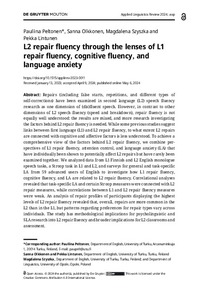The Relationship between L1 Fluency and L2 Fluency in Writing : a Mixed Methods Study of the Writing Fluency of the Finnish Learners of English by Using Keystroke Logging Data
Romo, Annastiina (2020-01-22)
The Relationship between L1 Fluency and L2 Fluency in Writing : a Mixed Methods Study of the Writing Fluency of the Finnish Learners of English by Using Keystroke Logging Data
Romo, Annastiina
(22.01.2020)
Julkaisu on tekijänoikeussäännösten alainen. Teosta voi lukea ja tulostaa henkilökohtaista käyttöä varten. Käyttö kaupallisiin tarkoituksiin on kielletty.
avoin
Julkaisun pysyvä osoite on:
https://urn.fi/URN:NBN:fi-fe202003047299
https://urn.fi/URN:NBN:fi-fe202003047299
Tiivistelmä
Second language (L2) fluency has been a widely researched topic in the field of SLA for many years. However, it is only recently that researchers have become interested in the possible effects of the first language (L1) on the L2 fluency, which means that these connections are still relatively poorly understood. Thus, the aim of this thesis was to explore the relationship between L1 and L2 fluency, focusing especially in writing fluency, which has been a neglected area of research compared to spoken fluency studies.
The research employed a mixed-methods approach to investigate the issue, where the quantitative analysis of different fluency measures was complemented with a more in-depth qualitative analysis of the fluency features of the essays. The data consisted of essays written by 16 Finnish upper-secondary school students in their L1 (Finnish) and L2 (English) by means of a keystroke recording tool ScriptLog. The samples were examined with the help of various writing fluency measures, which were based on participants’ pausing and revision behaviour. The essays were then analysed qualitatively by using a writer profile categorization. The results revealed positive statistically significant correlations on three of the measures: the number of pauses, the mean length of pauses and P-Burst. The regression analysis further supported the findings by indicating that the L2 fluency measures could be predicted from the equivalent L1 measures to some extent. The findings of the qualitative analysis showed that seven out of 16 participants shared similar composing processes in their L1 and L2. Thus, the findings together suggest that there is a link between L1 and L2 writing fluency to some degree, which should be acknowledged in future studies which focus on different factors affecting L2 fluency. In addition, the results of the present study can be used in teaching contexts by facilitating learners’ L2 writing and as a help of L2 fluency assessment.
The research employed a mixed-methods approach to investigate the issue, where the quantitative analysis of different fluency measures was complemented with a more in-depth qualitative analysis of the fluency features of the essays. The data consisted of essays written by 16 Finnish upper-secondary school students in their L1 (Finnish) and L2 (English) by means of a keystroke recording tool ScriptLog. The samples were examined with the help of various writing fluency measures, which were based on participants’ pausing and revision behaviour. The essays were then analysed qualitatively by using a writer profile categorization. The results revealed positive statistically significant correlations on three of the measures: the number of pauses, the mean length of pauses and P-Burst. The regression analysis further supported the findings by indicating that the L2 fluency measures could be predicted from the equivalent L1 measures to some extent. The findings of the qualitative analysis showed that seven out of 16 participants shared similar composing processes in their L1 and L2. Thus, the findings together suggest that there is a link between L1 and L2 writing fluency to some degree, which should be acknowledged in future studies which focus on different factors affecting L2 fluency. In addition, the results of the present study can be used in teaching contexts by facilitating learners’ L2 writing and as a help of L2 fluency assessment.
Samankaltainen aineisto
Näytetään aineisto, joilla on samankaltaisia nimekkeitä, tekijöitä tai asiasanoja.
-
L2 repair fluency through the lenses of L1 repair fluency, cognitive fluency, and language anxiety
Peltonen Pauliina; Olkkonen Sanna; Magdalena Szyszka; Lintunen Pekka<p>Repairs (including false starts, repetitions, and different types of self-corrections) have been examined in second language (L2) speech fluency research as one dimension of (dis)fluent speech. However, in contrast to ... -
Does Fluency Mean Intelligibility? A Mixed Methods Study on the Perceptions of Speech Fluency and Its Teaching among L2 English Teachers in Finland
Ollila, Matti (18.04.2024)This thesis examined how the concept of speech fluency is perceived by 85 L2 English teachers in Finland, in addition to finding out how they teach it in their classrooms. The study was a partial replication of an earlier ...suljettu -
Frequent native language use supports phonemic and semantic verbal fluency in L1 and L2: An extended analysis of verbal fluency task performance in an L1 language attrition population
Lehtinen Nana; Kautto Anna; Renvall Kati<p><b>Purpose:</b> Verbal fluency (VF) tasks are an efficient tool for exploring lexical retrieval. Attriters generally produce fewer words in semantic categories than monolinguals, but the processes underlying attriters' ...


